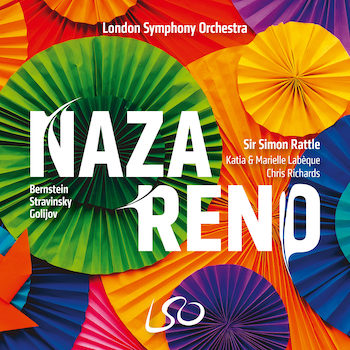Classical Music Review: Osvaldo Golijov’s “Nazareno”
By Jonathan Blumhofer
Nazareno is bright, often joyous, and easy on the ears. That ought to count for something.
 For Osvaldo Golijov, his St. Mark Passion, premiered in 2000, is the gift that keeps on giving. One of the 21st century’s most striking pieces, several individual numbers from it have taken on lives of their own, and, in 2010, Gonzalo Grau crafted a 30-minute-long work for two pianos and orchestra based on it. Called, Nazareno, the score is the anchor of the London Symphony Orchestra’s (LSO) eponymous new album.
For Osvaldo Golijov, his St. Mark Passion, premiered in 2000, is the gift that keeps on giving. One of the 21st century’s most striking pieces, several individual numbers from it have taken on lives of their own, and, in 2010, Gonzalo Grau crafted a 30-minute-long work for two pianos and orchestra based on it. Called, Nazareno, the score is the anchor of the London Symphony Orchestra’s (LSO) eponymous new album.
Even given the niche genre it inhabits, this is a double-piano concerto that doesn’t always do what one expects. For one, the keyboards are often embedded in the orchestral textures and the orchestra functions in solo roles nearly as frequently as the pianists do.
Then there’s the music itself, which broadly captures of the flavor of Golijov’s original work but manages, at times, to rather overstay its welcome. This is most problematic in the concluding “Processional,” which builds to climax after climax only to keep on going, but, throughout — in the lovely “Sur” as much as in the kinetic “Guaracha y Mambo” — there’s little evident rhyme or reason to either the organization of thematic materials or the concerto’s larger structural scheme.
Of course, maybe none of this matters: Nazareno is bright, often joyous, and easy on the ears. That ought to count for something. Its echoes of South and Latin American musics (like the opening “Berimbau” movement and the apparent snatch from The Champs’ “Tequila” in the “Mambo” — with the attendant stratospheric trumpet writing) are appealing.
And, occasionally, Grau’s writing for the full ensemble hits on something bracingly original, like the melding of both pianos with orchestra at the apex of the second movement, “Tambor en blanco y negro.” If the larger effort doesn’t scale the heights as touchingly as Golijov’s Azul does, well, that’s just how a piece comes out sometimes.
Regardless, the performance, featuring duo-pianists Katia and Marielle Labèque (for whom Grau crafted Nazareno), is vigorous and Sir Simon Rattle draws conspicuously responsive playing from the LSO.
There’s more of the same in the disc’s filler, which consists of Leonard Bernstein’s Prelude, Fugue & Riffs and Igor Stravinsky’s Ebony Concerto.
True, the Bernstein isn’t quite so raw as it might be: the “Fugue’s” climaxes, in particular, lack some bite (at least when compared to Rattle’s earlier effort with the London Sinfonietta). But the “Prelude” moves briskly and the “Riffs” let loose with admirable abandon, especially over the movement’s last half.
Meanwhile, Rattle’s take on the Stravinsky is dry and droll, ably capturing the music’s sense of wit and whimsy. Ostinatos drive and the Concerto’s contrasts of instrumental color — like the call-and-response between saxophone choir and muted trumpets in the Andante — all come out very well. You won’t probably want to trade in Stravinsky’s own recording of the piece (with Benny Goodman) for this one, but, of course, you don’t have to: here, Rattle and the LSO offer a nice, characterful complement to the old benchmark.
Jonathan Blumhofer is a composer and violist who has been active in the greater Boston area since 2004. His music has received numerous awards and been performed by various ensembles, including the American Composers Orchestra, Kiev Philharmonic, Camerata Chicago, Xanthos Ensemble, and Juventas New Music Group. Since receiving his doctorate from Boston University in 2010, Jon has taught at Clark University, Worcester Polytechnic Institute, and online for the University of Phoenix, in addition to writing music criticism for the Worcester Telegram & Gazette.
Tagged: Gonzalo Grau, Jonathan Blumhofer, London-Symphony-Orchestra, LSO Live, Nazareno, Osvaldo-Golijov, Simon Rattle’
